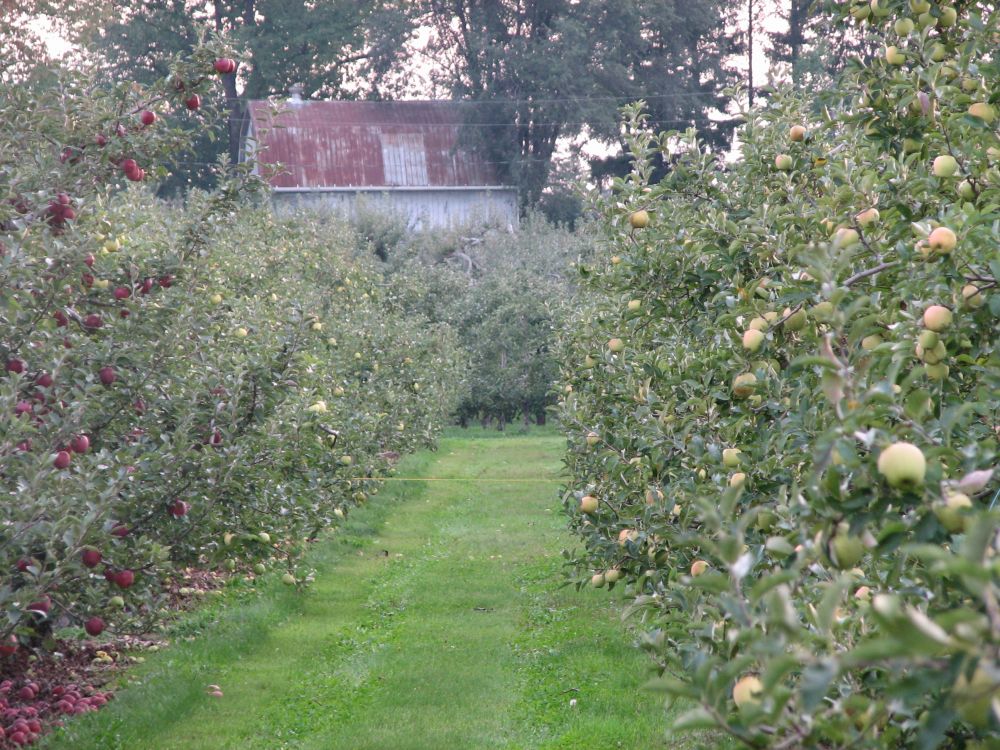Years later, I spent summers working pick-your-own strawberries and pick-your-own apples at Quint Ferri North Farm where my mother and her four siblings grew up. When I was sixteen, I moved there full-time and lived in a century-old home completely surrounded by an apple orchard. You could say I was more than a little influenced by farm life. My husband jokes that I like to pretend I'm a country girl even though I've lived most of my life in cities or suburbia. But the fact remains that the farm played a big part in my life and shaped my identity..
The fondest memories are of my visits there as a child and my time spent with my cousins during the harvests. I can remember every single autumn - biting into the first apple of the season. We grew about twenty varieties on our farm alone - many of which are hard to find. In my opinion Wealthy and McIntosh were only worth eating right off the tree. Golden and Red Delicious were once my favourites but then we started growing new varieties like Royal Gala and Jonagold. Nowadays Honeycrip takes the cake for sweetness and crunch.

Quint Ferri North Farm was sold to developers almost ten years ago. Like its neighbouring farms it held some of the most fertile soil in the country. Gone are the apple trees, houses and the places of my childhood. My favourite silver maple tree still towers over 60 feet tall and 6 feet across at the trunk, but it too will likely succumb to the chainsaws when the ground is regraded and a road is constructed for the future subdivison.
Selling was inevitable. Conventional farming and residential neighbourhoods just don't mix – at least on a large scale. I understand that the best farmland happens to be in the southernmost, and therefore most desirable, areas of Canada. But what saddens me is how the subdivisions are constructed. Every tree is removed and the land is stripped of its topsoil, leveled and compacted. The soil goes from the most fertile to the least. A process that took thousands of years is gone in a matter of days.
By now you’ve heard of Storyboard Furniture and their Apple Orchard Initiative. Their plan is to make everything from spoons to tables from about 400 salvaged apple trees, concerned not only with the wood butalso the stories that come along with it. By making beautiful pieces of functional art the artisans are saving pieces of history from the chipper. I have a large family - most of us grew up on or lived at some point of our lives on Heritage Road in Huttonville, a small village that is now part of Brampton – and the trees being used were once planted and tended to by members of my family.

Preserving heritage trees and as much of the natural topsoil is another way to save our natural history. Native grasses, trees and plants would also make new subdivisions more ecologically viable – and economically desirable (as property values rise with healthy urban tree canopies). Imagine we preserved green corridors for wildlife and plant communities, protected natural spaces for recreation, and conserved healthy soil and growing space (think urban farms and gardens). These relatively simple steps would make for more balanced urban landscapes and more sustainable communities as we face increased food insecurity, unpredictable weather patterns and economic instability.
I have more questions than answers. But I do wish we placed greater value on the ecological functions of our land – that at the very least we used space more responsibly as we make room for new neighbours.
As I write this, I’m sitting with my five-and-a-half month old son. Otherwise, I would be gearing up for the spring planting season at LEAF (Local Enhancement and Appreciation of Forests). It is nearly impossible to pinpoint the time in my life when I decided I needed to study and work with trees. What I know for sure is that watching my family grow food and be rooted to a landscape has influenced my life more than anything else.
These days I am happiest exploring a forest, including the urban forest of my neighbourhood, and tending to my vegetable garden. I cannot wait to tend the soil and harvest veggies with my son. It is very important to me to pass on to him the skills to grow his own food and I want him to not only understand but value ecological processes. I am excited to take him apple picking next autumn.

Most Canadians live in cities. Our society is one of mass production and convenience – but we must make a concerted effort to connect with our environment. Increasingly people are fed up with a wasteful society and strive instead to connect with the land, soil and where their food comes from. Today Storyboard Furniture is salvaging the wood for this project from my Great Uncle Nick’s farm. I am so thrilled Storyboard Furniture is giving new life to my family's apple trees. Their project is being crowd funded through indiegogo and you can donate and be a part of it here.
Update: Good news! Al Ferri's Farm on Heritage Road will still be open for pick-your-own apples and though the land is sold, Al's Country Store will remain even when the houses arrive.
Erin Silverstein began working with LEAF in 2010 after volunteering with them. She has a BSc from the University of Toronto in Forest Conservation and Geography. In 2011 she obtained her arborist certification and began doing onsite consultations for LEAF's Backyard Tree Planting Program and educating residents on the importance of our urban forest. She enjoys seeing tangible results in our urban landscapes through planting and maintenance and discussing the importance of trees and greenspace for clean air, stormwater management, and wildlife habitats.
